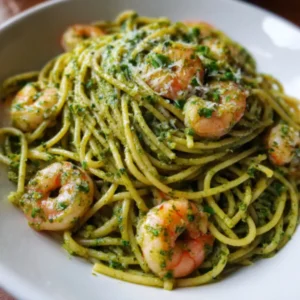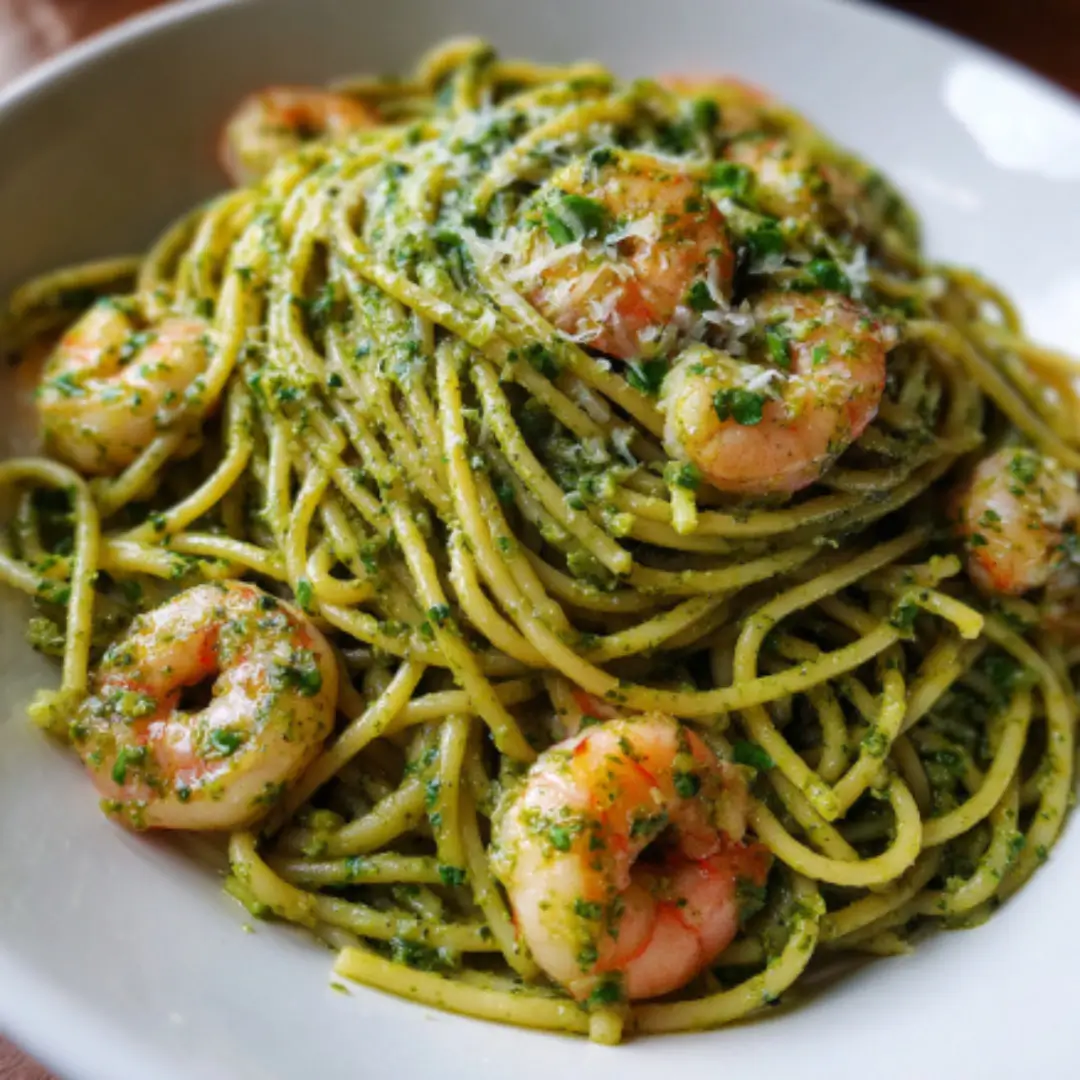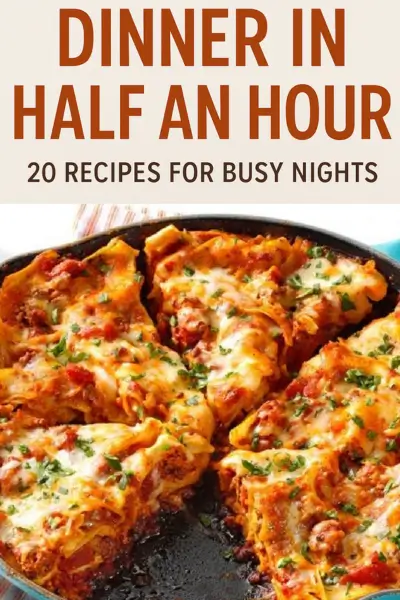Shrimp pesto pasta is an easy and tasty meal you can make quickly. It combines cooked shrimp with a fresh basil and almond pesto sauce, mixed with spaghetti noodles. This dish is full of flavor but simple to prepare, making it perfect for any day when you want something satisfying without a lot of fuss.
Why You’ll Love Shrimp Pesto Pasta
You’ll quickly find this shrimp pesto pasta becoming a favorite for several reasons. First, it’s incredibly fresh and flavorful, thanks to the basil almond pesto that bursts with herbaceous notes and a hint of lemon. The shrimp add a delicate sweetness and protein punch that makes this dish both filling and healthy. It’s also highly adaptable — you can easily swap ingredients to suit your taste or what you have on hand. Whether you’re cooking for a family dinner or meal prepping for the week, this recipe fits the bill with its quick cook time and minimal fuss. Finally, the dish looks gorgeous on the plate with vibrant green pesto coating golden shrimp and long, glossy pasta strands. You’re not just feeding yourself — you’re creating a dish to impress.
Ingredients You’ll Need for Shrimp Pesto Pasta
- 3 cups fresh basil leaves (destemmed)
- ¼ cup slivered almonds
- 2 garlic cloves
- Zest and juice of 1 lemon
- 2 tablespoons grated Parmesan cheese
- ½ cup extra virgin olive oil
- 1 pound spaghetti
- 1 pound raw shrimp, peeled and deveined
- 1 tablespoon olive oil
- Salt and pepper, to taste
How to Make Shrimp Pesto Pasta: Step-by-Step Directions
Start by making your pesto sauce. Place the fresh basil, slivered almonds, garlic cloves, lemon zest, lemon juice, and Parmesan cheese into the bowl of a food processor. Pulse these ingredients until finely minced. With the machine running, slowly pour in the olive oil until the mixture becomes smooth and well combined. Set this vibrant green pesto aside while you prepare the rest of the dish.
Next, bring a large pot of salted water to a rolling boil. Add the spaghetti noodles and cook according to the package instructions until they reach al dente texture — firm to the bite but fully cooked. Before draining, reserve about one cup of the pasta cooking water. This starchy water will help loosen the pesto sauce later. Drain the pasta in a colander and set it aside.
Now, it’s time to cook the shrimp. Place the peeled and deveined shrimp in a bowl and season them generously with salt and pepper. Heat the olive oil in the large empty pasta pot over medium heat. Once the oil is hot, add the shrimp in a single layer. Cook each side for about 2 to 3 minutes or until the shrimp turns a bright pink color and becomes opaque throughout. Avoid overcooking to keep them tender.
After the shrimp is cooked, add the drained spaghetti back into the pot with the shrimp. Pour in some of the reserved pasta water to help create a silky sauce. Stir gently to combine shrimp and pasta evenly. Then, spoon in the pesto sauce. Toss everything together until the pasta is thoroughly coated with the pesto and the shrimp are well distributed.
Divide the shrimp pesto pasta into six serving bowls or plates. If you want to add a touch of extra freshness, sprinkle a few fresh basil leaves on top or a little extra grated Parmesan. Serve immediately while the dish is warm and fragrant.
How to Serve Shrimp Pesto Pasta for the Best Experience
Serving shrimp pesto pasta is simple but can be elevated with a few thoughtful touches. You can pair this pasta with a crisp green salad tossed in a light vinaigrette to add contrast and balance. A side of crusty bread or garlic bread also works well to soak up any leftover pesto sauce on the plate. For an extra layer of flavor, a squeeze of fresh lemon juice right before eating brightens the dish beautifully.
Consider adding grilled or roasted vegetables alongside your pasta to make a more substantial meal. Seasonal veggies like asparagus, cherry tomatoes, or zucchini complement the fresh basil flavor perfectly. You could also serve this dish as part of a larger Mediterranean-inspired dinner, with olives, marinated artichokes, or a light bean salad to accompany it.
If you want a slightly lighter meal, try substituting half or all of the spaghetti for spiralized zucchini noodles. This gives you a refreshing texture and reduces carbs while keeping the pesto and shrimp as the stars of the plate.
Expert Tips for Making the Perfect Shrimp Pesto Pasta
To get the most out of this recipe, here are some expert tips that can elevate your shrimp pesto pasta to restaurant-quality:
- Use fresh basil leaves that are bright green and fragrant. Avoid basil that looks wilted or yellowing to ensure the best pesto flavor.
- Toast the slivered almonds lightly in a dry skillet before adding to the food processor. This brings out a nuttier flavor and adds depth to the pesto.
- Don’t skip reserving pasta water. The starchy water helps the pesto cling better to the pasta and creates a silky texture rather than a dry coating.
- Cook shrimp just until pink and opaque. Overcooked shrimp can become rubbery and tough, so keep a close eye.
- If you don’t have Parmesan cheese, Pecorino Romano works as a substitute for a slightly sharper taste.
- To store leftover pesto, keep it in an airtight container with a thin layer of olive oil on top to prevent browning.
- You can make the pesto a day ahead to save time. Just bring it to room temperature before tossing with warm pasta.
- Experiment with adding a pinch of red pepper flakes to the pesto for a subtle spicy kick.
How to Store Shrimp Pesto Pasta Properly
If you have leftovers, store the shrimp pesto pasta in an airtight container in the refrigerator. It’s best consumed within 3 to 4 days for optimal freshness and flavor. When reheating, warm the pasta gently in a skillet or microwave to avoid drying it out. Adding a splash of water or extra olive oil can help loosen the sauce if it has thickened.
The pesto sauce alone can be stored separately in the fridge for up to 7 days. If you want to freeze pesto, place it in an airtight container or freezer-safe bag and freeze for up to 3 months. Thaw it overnight in the refrigerator before use.
Avoid freezing the cooked shrimp with the pasta, as the texture of shrimp can change after freezing and thawing, becoming less tender. Instead, it’s better to cook fresh shrimp when serving leftovers.
Variations to Customize Your Shrimp Pesto Pasta
This shrimp pesto pasta recipe is very flexible, so you can customize it based on your preferences or what’s in your pantry.
- Swap slivered almonds with walnuts, pine nuts, or cashews to change the nutty flavor of the pesto.
- Try adding baby kale or spinach leaves along with or instead of basil for a slightly different herbal note and extra nutrients.
- Use gluten-free pasta or spiralized vegetables like zucchini or carrot noodles to make the dish gluten-free or lower carb.
- For extra protein variety, substitute shrimp with cooked chicken breast, scallops, or firm tofu cubes.
- Add sun-dried tomatoes or roasted red peppers into the pesto for a sweeter, more robust sauce.
- Incorporate a handful of fresh herbs such as parsley or mint for a unique twist.
- If you enjoy heat, sprinkle crushed red pepper flakes on top or blend some chili peppers into your pesto sauce.
Feel free to get creative and adjust the recipe to fit your taste or dietary needs.
Frequently Asked Questions About Shrimp Pesto Pasta
What kind of shrimp is best for this recipe?
You want raw shrimp that are peeled, deveined, and tails removed if preferred. Medium to large shrimp work best for even cooking and a good bite.
Can I make the pesto ahead of time?
Yes! The pesto can be prepared up to a week in advance and stored in the refrigerator. Just cover it with olive oil to keep it fresh.
How long can I store leftover shrimp pesto pasta?
Store leftovers in an airtight container in the fridge for 3 to 4 days. It’s best eaten within this timeframe for flavor and food safety.
Can I freeze shrimp pesto pasta?
It’s best not to freeze the cooked shrimp and pasta together, as shrimp texture may suffer. You can freeze the pesto sauce separately for up to 3 months.
Is there a substitute for Parmesan cheese in the pesto?
Pecorino Romano is a good alternative. For a vegan version, you can use nutritional yeast instead.
Can I use other nuts besides almonds in the pesto?
Absolutely. Walnuts, pine nuts, or cashews can be used based on your preference or what you have available.
How do I make the pesto sauce creamier?
You can add a small amount of ricotta cheese or soaked cashews blended into the pesto for a creamier texture.
How spicy is shrimp pesto pasta?
This recipe is mild, but you can adjust the heat level by adding red pepper flakes or chili peppers to your pesto or as a topping.

Shrimp Pesto Pasta
Equipment
- Food Processor
- Large Pot
- Colander
Ingredients
- 3 cups fresh basil leaves destemmed
- 1/4 cup slivered almonds
- 2 cloves garlic
- 1 lemon zest and juice
- 2 tablespoons grated Parmesan cheese
- 1/2 cup extra virgin olive oil
- 1 pound spaghetti
- 1 pound raw shrimp peeled and deveined
- 1 tablespoon olive oil
- Salt and pepper to taste
Instructions
- In a food processor, combine basil, slivered almonds, garlic, lemon zest, lemon juice, and Parmesan cheese. Pulse until finely minced, then slowly add olive oil while blending until smooth.
- Bring a large pot of salted water to a boil. Cook spaghetti according to package instructions until al dente. Reserve 1 cup of pasta water, then drain the pasta.
- In the same pot, heat olive oil over medium heat. Add shrimp and cook for 2-3 minutes on each side until pink and opaque. Avoid overcooking.
- Add the drained spaghetti back to the pot with shrimp. Pour in reserved pasta water and stir to combine.
- Stir in the pesto sauce until pasta is thoroughly coated. Serve immediately, garnished with fresh basil or extra Parmesan if desired.
Send me this recipe!
Just enter your email below and get it sent straight to your inbox!



